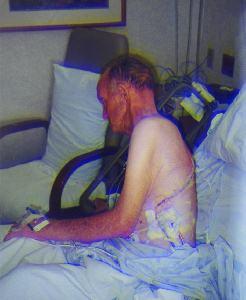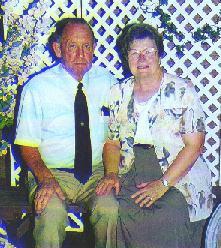Ex-Marine Back on His Feet
In December of 1998, 67 year old Bulan "BJ" Weech developed a harsh cough that continued for the next several months. At first, BJ thought it was just an ordinary cold. When the cough persisted he went to his family physician for chest films and a CT scan. The films revealed a left-sided pleural effusion. The doctors drained the fluid from his pleural cavity, which helped relieve the chronic discomfort. The fluid was sent to the pathology department for testing. A solid diagnosis could not be made.
In February, BJ underwent a thoracoscopy with biopsy and talc pleurodesis at the Desert Samaritan Hospital in Mesa, Arizona. The local pathologists diagnosed pleural epithelial mesothelioma. The local pathologists sought a second opinion from Dr. Thomas Colby (who is a member of the US-Canadian Mesothelioma Panel). Dr. Colby confirmed the diagnosis.
BJ immediately began radiation and chemotherapy treatments in Mesa, Arizona. After completing eight (8) radiation treatments and one (1) cycle of chemotherapy (Doxorubicin and Cisplatin) BJ and his familyrealized that his particular tumor needed the attention of specialists.
The Weeches, whose son Bradley is a successful commerical litigator in Mesa, searched the Internet. They found our website and contacted Dr. Robert B. Cameron at the UCLA Medical Center, who is also a director on the Mesothelioma Applied Research Foundation, Inc. The Weech's met with Dr. Cameron on February 26, 1999.
Dr. Cameron explained the treatment options that were available, including alternative or experimental agents, extra pleural pneumonectomy (EPP, where the lung is removed), gene therapy, and pleurectomy and decortication. Dr. Cameron decided BJ was a good candidate for a pleurectomy and decortication, a procedure in which the outer membranes of the lung are removed but the actual lung organ itself is spared. Dr. Cameron also discouraged BJ from continuing his chemotherapy since, in his medical opinion, chemotherapy had not been very useful in treating mesothelioma.
BJ agreed to the surgery -- a radical parietal pleurectomy and decortication. Dr. Cameron scheduled the surgery for March 18, 1999 at the UCLA Medical Center. Once the surgery had begun, Dr. Cameron found that the tumor had attached itself to BJ's chest wall, and had enveloped the entire lobe of the lung. In addition, the tumor was suffocating the phrenic and vagus nerves, the aorta, the lower pericardium and the diaphragm. Dr. Cameron described the tumor mass as an "inch thick crust".
Dr. Cameron noted that he could not detect any evidence that the chemotherapy that BJ had been receiving resulted in any positive reduction of tumor.
The surgery lasted nine and 1/2 grueling hours, but Dr. Cameron was confident that he had removed all of the tumor that he could see. The Weech's were very pleased with Dr. Cameron and his staff. Brad, who spoke to Dr. Cameron just after the operation, was impressed: "Dr. Cameron is amazing. After almost 10 hours, he came out of the surgery looking like he just got up. As far as I know, the man doesn't eat or sleep. We were very impressed with the entire crew. They are very dedicated and talented."
On March 27, 1999, BJ's last chest tube was removed. After changing his epidural anesthesia to oral pain medication, BJ was released from the hospital on March 28 -- ten (10) days after surgery. He returned home to Pima, Arizona where he intended to stay for two weeks, a time in which BJ would try to focus on healing and rebuilding his strength. The plan was for him to recuperate at home for two weeks and then return to Dr. Cameron's office for a checkup. He was then scheduled to undergo radiation

On March 30, however, BJ was rushed to the Mt. Graham Community Hospital in Safford, Arizona. He was in tremendous pain. After 12 grueling and painful hours in the hospital ER, the doctors could neither diagnose nor treat his symptoms. Their only choice was to air-evacuate (via helicopter) Mr. Weech to the University Medical Center in Tucson, Arizona. He underwent a battery of tests to determine the source of his pain.
Along the way, the doctors removed nearly 1300 cc's of brown, bloody fluid from his stomach, which they described as like "coffee grounds." He was connected to a stomach pump. The doctors suspected that BJ's diaphragm had been breached or herniated. BJ was in terrible pain. He would not talk or eat. Dr. Cameron was immediately contacted. For the second time, BJ was again air-evacuated to the UCLA Medical Center for emergency follow up treatment under the direction of Dr. Cameron. BJ's wife and son Brad arrived later that same night.
On April 6, Dr. Cameron operated a second time on BJ, this time to repair BJ's diaphragm. BJ was weak but itching to get home. He continued to have pain and was connected to two chest tubes. He had been in and out of hospitals for the past nine (9) weeks. He had lost nearly forty (40) pounds. But he did not lose his most powerful assets: his loving family and his will to fight back. In fact, he and his family's collective resolve to turn the tides against this terrible tumor strengthened.
On Thursday, April 29, BJ was finally discharged from the hospital. He stayed in Los Angeles over the weekend to build up his strength for the trip home. BJ was tired of appearing helpless. He had been rushed to too many emergency rooms. He had nearly died. His immeidate goal was elegant in its simplicity: he simply wished to walk out of the hospital, walk through the airport, walk on to the plane, walk out and walk home. In order to repair the damage, BJ realized that he first must have a dream, a vision. His dream was a life without doctors, IVs, chest tubes, and wheelchairs.
BJ Weech is an unsually tough man. He's an ex-Marine who was trained to survive in the muck where the difference between living and dying was simply a matter of faith and luck. He believes in God, Family and Honor. The man has a Code. A good code is one you don't break. BJ doesn't change his code daily when it's convenient or expedient. He has that rare stick-to-it-ivenss that has helped him persevere and overcome.
BJ has lived by these virtues and tried his best to inculcate these values in his five children. He and his wife Joanna have been married for 44 years. Throughout his medical ordeal, BJ's wife has been at her husband's side every day. She has been BJ's doctor, nurse, clergy, cheerleader and friend. BJ has always been a working man, never one to sit around and watch the paint dry. The last six months have tried BJ's faith. Pain? Yes, BJ has endured more pain than any man ever should. But the worst part was the loss of liberty, the loss of freedom, the "confinement" in hospital rooms. One of the first things BJ said to me was he had "no time to get sick" because there was a pile of wood up at Mt. Graham that he needed to chop.
They say that in times of trouble you learn who your friends are. BJ Weech has many friends. Nearly the entire town of Pima, in addition to the entire Gila Valley in Graham County, has turned out to help the Weech family fight this disease and lend support. The entire community has mobilized to help out. It's like an old fashioned "barn raising" except here BJ is the barn.
Dr. Cameron is continuing to monitor BJ's progress. He recommended a doctor in Scottsdale, Arizona to oversee BJ's radiation treatments (which have now started).
BJ is gradually getting stronger. He walks ½ a mile a day, twice a day. He is better able to control his pain level. BJ did manage to walk out of that hospital and walk into his own home. The next step is to go back up to Mt. Graham and take care of that timber.
"I'm happier now, but I'll be a whole lot happier when I can swing my axe again."
*** POSTED JUNE 16, 1999 ***
On May 9, 2000, Bulan's battle ended. Our prayers are with his family.

